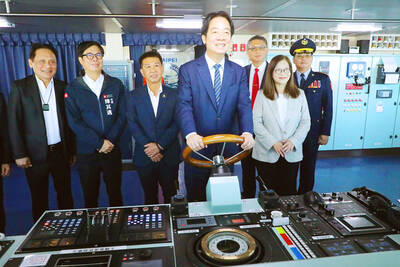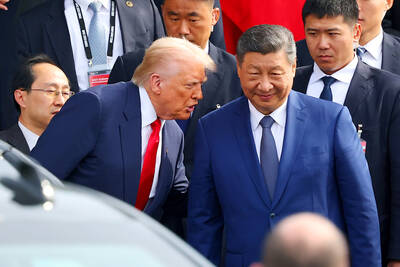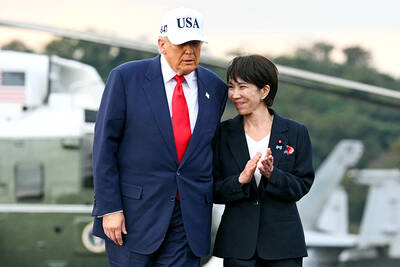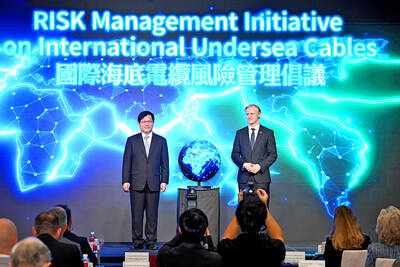After hanging over the entrance of the Presidential Office since 1948, a sign criticized as a relic of authoritarianism was replaced yesterday by the Democratic Progressive Party (DPP) administration, officially changing the office's name.
The name of the Presidential Office was "Chiehshou Hall" -- literally "Long live Kai-shek Hall" -- and the building had a marble sign with its name inscribed in Chinese characters (
The new sign, installed yesterday, reads simply "Presidential Office" in Chinese characters (
A statement by the Presidential Office said the move reflected not only the real sense of the building's name but also had constitutional meaning.
The marble sign reading "Chiehshou Hall" will be placed in the Academia Historica for public display, said a statement issued by the Presidential Office's Department of Public Affairs yesterday.
The department said the move was appropriate, because the building is where the president and vice president work, rather than a specific individual's personal villa or hall.
"Changing the name over the building's entrance from `Chieh-shou Hall' to `Presidential Office' not only makes the building worthy of its genuine name, but also carries constitutional meaning," the statement said.
colonial past
The Presidential Office's history stretches back to the Japanese colonial era. It was designed by the architect Uheiji Nagano in 1910, and was completed in 1919. The building, which was the office of the Japanese governor-general of Taiwan, was bombed by Allied forces during World War II, on May 31, 1945. Part of the building was destroyed in the bomb attack, and burned for three days.
One year after the war ended, the Taiwan Provincial Government raised funds to restore the building. The rehabilitation project was completed in 1948, and the building was named "Chiehshou Hall."
When the Chinese Nationalist Party (KMT) was defeated by the Chinese Communist Party during the Civil War, the remnants of its forces fled to Taiwan in 1949. The building became the office of the president and the premier in 1950. The office of the premier was later moved out of the building, in 1957.
The department said that as Taiwan has transformed from an authoritarian state to a genuine democracy, the name change was necessary and symbolized the restoration of power from the state to the people.
The department said that it began planning the change in October.
The Taiwan Solidarity Union (TSU) caucus yesterday said the name change "liberates Taiwan's democracy."
"Naming all the important buildings after Chiang Kai-shek (
`boring' move
However, opposition lawmakers criticized the Presidential Office, saying the move was "boring" and meaningless. Some equated the change to China's Cultural Revolution.
"Taiwan's 23 million people should be the focus of the government. Unfortunately, our government only cares about something like this. Changing names? I think there are a lot of better things to do, aren't there?" said Chinese Nationalist Party (KMT) Legislator Pan Wei-kang (
People First Party (PFP) Legislator Lee Hung-chun (
"If [the DPP government] wants to do something remarkable, I would suggest it focus on economic and criminal issues, because these issues concern everyone of us," Lee said.
The Democratic Progressive Party (DPP) caucus said the Presidential Office was merely doing something that needed to be done.
"What do you want to call the president's office if you do not call it the `Presidential Office?'" said DPP legislative caucus secretary-general Yeh Yi-ching (
The change should have "been made a long time ago, anyway," Yeh added.

CALL FOR SUPPORT: President William Lai called on lawmakers across party lines to ensure the livelihood of Taiwanese and that national security is protected President William Lai (賴清德) yesterday called for bipartisan support for Taiwan’s investment in self-defense capabilities at the christening and launch of two coast guard vessels at CSBC Corp, Taiwan’s (台灣國際造船) shipyard in Kaohsiung. The Taipei (台北) is the fourth and final ship of the Chiayi-class offshore patrol vessels, and the Siraya (西拉雅) is the Coast Guard Administration’s (CGA) first-ever ocean patrol vessel, the government said. The Taipei is the fourth and final ship of the Chiayi-class offshore patrol vessels with a displacement of about 4,000 tonnes, Lai said. This ship class was ordered as a result of former president Tsai Ing-wen’s (蔡英文) 2018

UKRAINE, NVIDIA: The US leader said the subject of Russia’s war had come up ‘very strongly,’ while Jenson Huang was hoping that the conversation was good Chinese President Xi Jinping (習近平) and US President Donald Trump had differing takes following their meeting in Busan, South Korea, yesterday. Xi said that the two sides should complete follow-up work as soon as possible to deliver tangible results that would provide “peace of mind” to China, the US and the rest of the world, while Trump hailed the “great success” of the talks. The two discussed trade, including a deal to reduce tariffs slapped on China for its role in the fentanyl trade, as well as cooperation in ending the war in Ukraine, among other issues, but they did not mention

Japanese Prime Minister Sanae Takaichi yesterday lavished US President Donald Trump with praise and vows of a “golden age” of ties on his visit to Tokyo, before inking a deal with Washington aimed at securing critical minerals. Takaichi — Japan’s first female prime minister — pulled out all the stops for Trump in her opening test on the international stage and even announced that she would nominate him for a Nobel Peace Prize, the White House said. Trump has become increasingly focused on the Nobel since his return to power in January and claims to have ended several conflicts around the world,

GLOBAL PROJECT: Underseas cables ‘are the nervous system of democratic connectivity,’ which is under stress, Member of the European Parliament Rihards Kols said The government yesterday launched an initiative to promote global cooperation on improved security of undersea cables, following reported disruptions of such cables near Taiwan and around the world. The Management Initiative on International Undersea Cables aims to “bring together stakeholders, align standards, promote best practices and turn shared concerns into beneficial cooperation,” Minister of Foreign Affairs Lin Chia-lung (林佳龍) said at a seminar in Taipei. The project would be known as “RISK,” an acronym for risk mitigation, information sharing, systemic reform and knowledge building, he said at the seminar, titled “Taiwan-Europe Subsea Cable Security Cooperation Forum.” Taiwan sits at a vital junction on